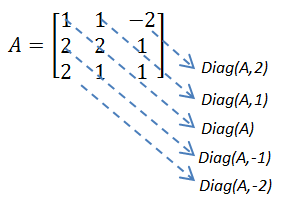

B contains the same elements as A, except the rows and columns are interchanged. If you'd like to learn more, it's worth reading about representation theory. Create a matrix containing complex elements and compute its nonconjugate transpose. Hence - when you transpose a matrix over the complex numbers, Matlab helpfully completes the job by conjugating the elements for you as well. It just so happens that for historical reasons we developed the algebraic form using the symbols j or i first, and invented the idea of conjugation, which is really just a special case of the transpose. The work must be accomplished anywhere: Either in Matlab by calculating the complete transposed matrix, although only a part is needed, or inside your brain, such that the indirection. If you like, the natural representation is the 2nx2n real form. There are 2 ways only: Create the transposed explicitly: MT M' k MT (1,:) Create your own algorithm, which extract directly, what you need: k M (:,1).'. B rot90 (A,k) rotates array A counterclockwise by k90 degrees, where k is an integer. For multidimensional arrays, rot90 rotates in the plane formed by the first and second dimensions. It's not surprising that we don't find it in natural laws! B rot90 (A) rotates array A counterclockwise by 90 degrees. With this in mind, I'd say that the "ordinary transpose" of a matrix over the complex numbers is actually a very strange thing. In fact I'll go further and claim (without proof) that any vector or matrix over the complex numbers has an isomorphism in vectors/matrices over the reals (the latter having double the dimensionality), and that conjugate-transposition in the complex version is identical to transposition in the real version. What happens if we have an nxn matrix of complex numbers? Why then we can just represent it as a 2nx2n matrix of real numbers, where each 2x2 sub-matrix is of the form xI + yJ! Turns out if you do so that the Hermitian (conjugate) transpose of the nxn complex matrix is just equivalent to the ordinary transpose in the 2nx2n real form. So conjugating the complex number was the same operation as transposing its matrix representation. Then we have this equivalence (using j to denote the imaginary unit): x + yj xI + yJ
#Matlab transpose matrix code#
X3Dtranspermute (X, 2,1,3) But above code is for. I want implement matrix transpose in MATLAB which denotes by ' (Not (.')) for the 3D matrix.

Let I = (1 0) J = (0 -1)Īnd notice that the transpose of J ( J^T) is just equal to -J. I have a 3D matrix which its size is 185x145x3.

And even if there is some version (maybe future) of MATLAB that does this optimization, it is still only the physical transpose part that could beat the direct implementation. I get the same results as Matt on various versions. Consider a matrix representation of complex numbers. BtB.' traceProduct A (:).'Bt (:) 4 Comments. Actually I'd argue that there are deep reasons why the transpose IS the conjugate. MATLAB Data Import and Analysis Data Import and Export Workspace Variables and MAT-Files.


 0 kommentar(er)
0 kommentar(er)
